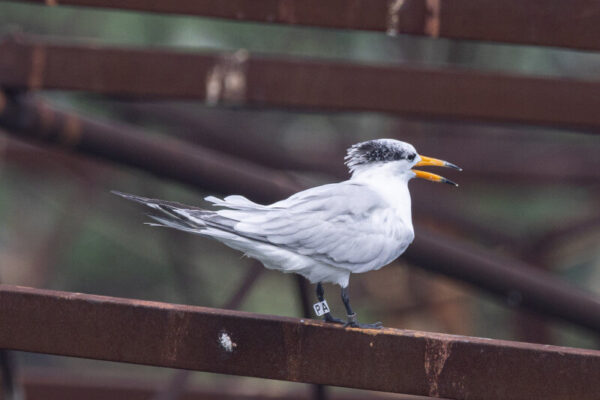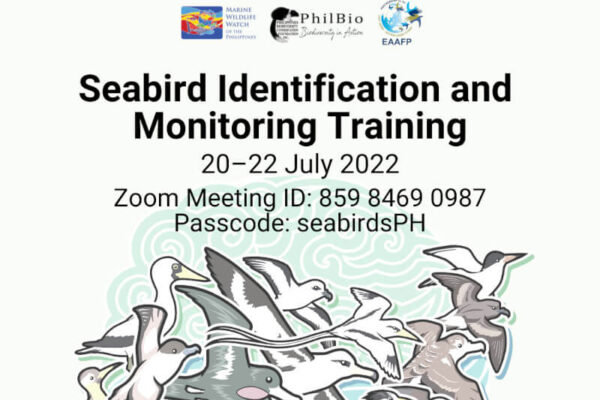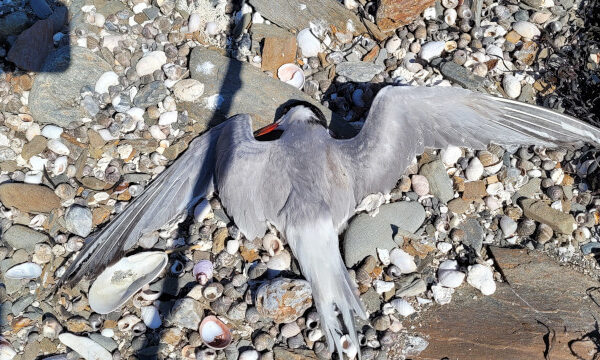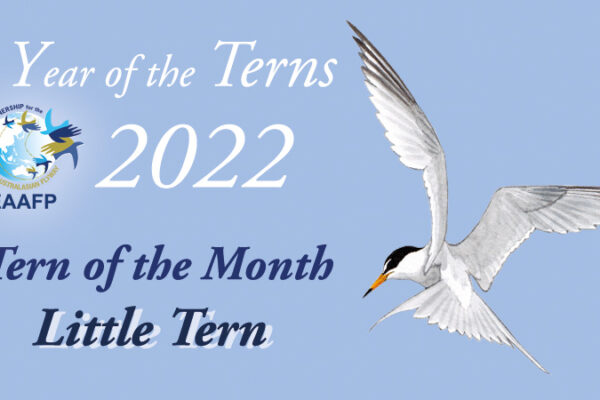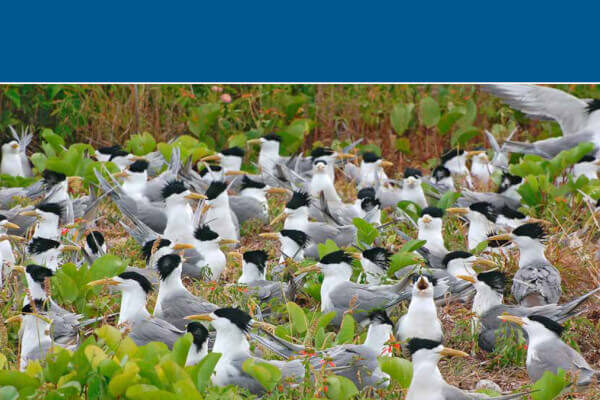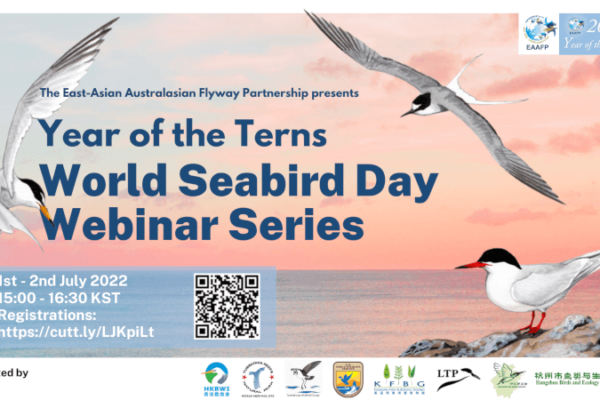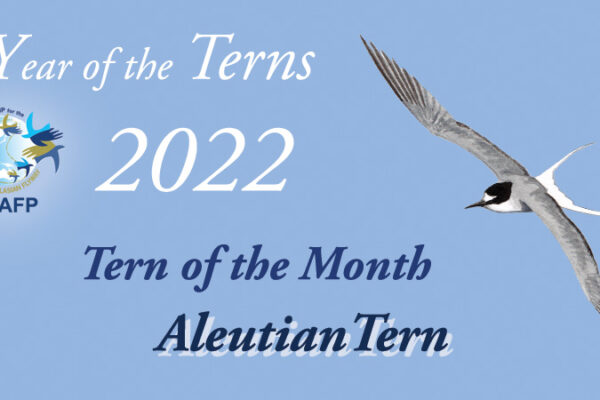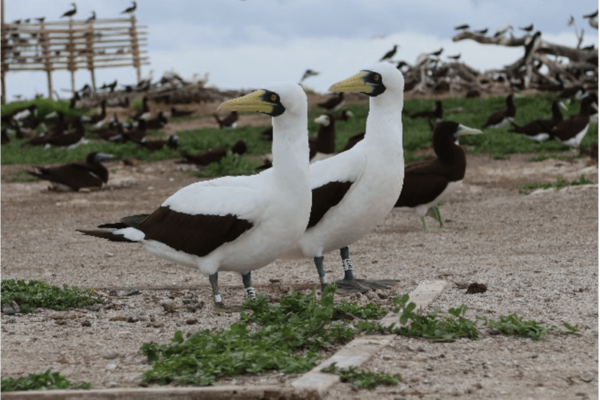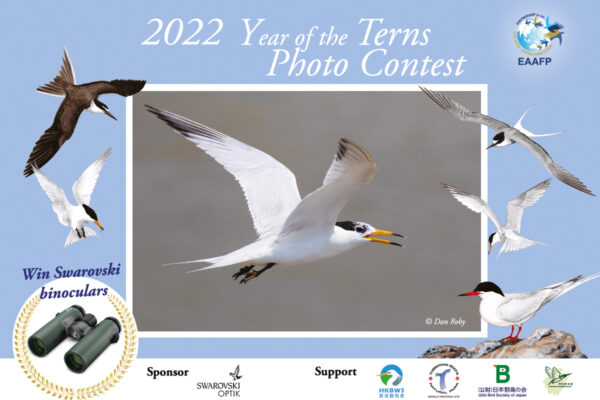-
Chinese Crested Tern banded in Republic of Korea sighted in China
The connection between RoK-breeding Critically Endangered Chinese Crested Tern and…
Continue reading -
The Philippines conducts its 1st National Training on Seabird Identification and Monitoring
In the effort to increase our knowledge and capacities in conserving seabirds in the Philippines, the Biodiversity Management Bureau of the Department of…
Continue reading -
Little Tern
Little Tern ©Kenneth Lam Common name:Little Tern Scientific name: Sternula albifrons Local names: Малая крачка(Russian), Хурган хараалай(Mongolian), 白额燕鸥 (Simplified Chinese), 白額燕鷗/小燕鷗 (traditional Chinese), 쇠제비갈매기 (Korean), コアジサシ(Japanese), Dara laut kecil (Indonesian), Camar Kecil (Malayu), Nhàn nhỏ (Vietnamese), นกนางนวลแกลบเล็ก (Thai). Conservation status: IUCN - Least Concern The Little Tern is one of the smallest tern species in EAA Flyway. It has wide distribution range across the East Asian-Australasian Flyway and the East Atlantic Flyway. Five subspecies recognized: Sternula albifrons albifrons; Sternula albifrons innominate; Sternula albifrons guineae; Sternula albifrons sinensis and Sternula albifrons placens, with the later two subspecies S. a. sinensis and S. a. placens found within the EAA Flyway. Identification Size: 22–28 cm; wingspan 47–55 cm. Body: slender light grey wings and body, with a white rump, tail long and forked Breeding plumage Head: distinctive white forehead, black cap and lores. Beak: bright yellow beak with a small black tip Orange-yellow legs Non-breeding Plumage Head: forehead is more predominantly white Beak: blackish beak Dull orange to blackish legs Juveniles appear like the non-breeding adults, except for a narrower black rear crown, and a more brownish-white forehead and crown. They have a U-shaped marking which is visible on the shoulders Little Terns can be confused with Fairy Terns (Sternula neresis), Saunder's Terns (Sternula saundersi), Least Terns (Sternula antillarum), Yellow-billed Terns (Sternula superciliaris), and Peruvian Terns (Sternula lorata). Distribution range Sternula albifrons sinensis: Palaearctic breeders in southeastern Siberia, Korea Penisular, Japan and China migrate south in the non-breeding season, mainly in the tropical region, but could reach down to New Guinea and Australia. Some are also found all year round in northern India and Sri Lanka east to southeastern Asia, the Philippines, and northern Australia. Sternula albifrons placens: East Australia and East Tasmania Habitat Breeding habitat Little Tern breeds on sand spits, banks, ridges or islets, and sandy beaches in coastal environments including coastal lakes, estuaries and inlets. The nest is a shallow scrape positioned on the ground above the high tide-line and often only a few meters away from shallow clear water where it lays one to three eggs a clutch. Breeding habitat of Little Tern © Yutaka Otsuka Non-breeding habitat Coastal tidal creeks, lagoons and saltpans; sometimes feed in the open sea. Non-breeding site in Singapore ©Kenneth Lam Behavior Little Terns is a ground-nesting bird and it nests in small loose colonies., with the distance between nests usually more than 2m. Breeding colonies are small to medium-sized, up to 40 pairs, seldom > 100 pairs. Little Tern shows moderately high site fidelity. Courtship occurs by presenting and feeding the females with fish and may last from a few days to weeks. Population estimate The global population is estimated to number c.190,000-410,000 individuals. There is no accurate census date for subspecies S.a. sinensis but estimated to 10,000 – 100,000 birds, while S. a. placens is estimated to have 10,000 birds. Main threats Habitat loss by reclamation Human disturbance, e.g. recreational and tourism activities at coastal areas close to breeding colonies Stray or feral dogs and cats at breeding sites. Other threats: Pollution Egg collection Artificially-induced water-level fluctuation Sand-mining Natural threats: Flooding Adverse weather conditions, e.g. typhoons, heavy rains, strong winds and waves Natural predators (e.g. Peregrine Falcon, snakes, rats) Conservation Work Artificial breeding habitat on building rooftop in Tokyo, Japan to restore Little Tern breeding colony Since 2001, a new NGO Little Tern Project has been established to manage the initiative of building artificial breeding habitats on the rooftop of buildings in Tokyo Bay, Japan. This sustained over 2000 nests, although the population fluctuate due to various factors. The project also integrates with local community engagement and citizen science. Conservation of Little Tern is also part of local policy, e.g. Basic Environmental Plan of Ota City. Learn more: https://littletern.net/ Little Tern breeding at Morigasaki Water Reclamation Center of Tokyo © Little Tern Project Tracking and studies on migratory routes of Little Tern There are independent or internationally collaborative banding and tracking projects on Little Tern. Banding and colour-marking have been done in Australia by New South Wales (NSW) National Park and Wildlife Services (2003). In Japan, Yamashina Institute of Ornithology, Japanese Society for Preservation of Birds and Little Tern Project had banding and banding programme, and utilize of geo-locators. Japan had a collaborative project with Australia between 2012-2015 (link). In Guangdong, China, a joint research carried out by Little Tern Project, Hong Kong Bird Watching Society, Guangdong Haifeng Bird Provincial Nature Reserve Office, and Sun Yat-sen University has done colour-marking on Little Terns in 2017 and 2018. A yellow ring with a white engraving of A and 2 numerals had been placed on the right tarsus, as shown in the photo below (Yu, pers. comms.). However, further surveys in 2018 could not find any colour-marked Little Tern at this site. A Little Tern with geolocator ©Eugene Cheah Little Tern Recovery Plan in New South Wales, Australia The Little Tern is listed as Endangered in New South Wales of Australia under the Threatened Species Conservation Act 1995 (TSC Act). This Recovery Plan was launched in 2003, which constitutes the approved NSW State Recovery Plan for the Little Tern. It covers conservation requirements of the species across and identifies conservation actions to be undertaken to ensure the long-term survivorship of the species. Learn more: link © New South Wales Government Fun Fact A Little Tern in Australia had been recorded to reach 17 years old. Generally, Little Terns start breeding from 3 years old, occasionally at 2 years old. Regarding species looks similar to the Little Tern, while Fairy Tern might turn up in Indonesia and Saunders’s Tern in western SE Asia, Yellow-billed Tern and Peruvian Tern are highly unlikely to be found in EAAF countries. The most frequent confusion is with the Least Tern. It is an uncommon but regular visitor to Japan (first confirmed record was a banded bird from North Dekota, USA recovered at the coast of Ibaraki Prefecture, Japan in July 2014) and probably can occasionally be found in eastern Asia. References IUCN Red List: https://www.iucnredlist.org/species/22694656/155476219 Birds of the World: https://birdsoftheworld.org/bow/species/litter1/cur/introduction Gochang Big Bird Race 2023 brought birdwatchers to contribute bird data to the UNESCO World Heritage Site Special achievement award to the Chinese Crested Tern team Webinar on Chinese Crested Tern in the Yellow Sea and Seabird Conservation in China Chinese Crested Tern banded in Republic of Korea sighted in China Chinese Crested Tern Restoration of the Critically Endangered Chinese Crested Tern using social attraction technique A Conservation Success in Minjiang River Estuary A tern for the better Critically Endangered Chinese Crested Terns appear on a deserted island in South Korea The First Ever Banded Chinese Crested Tern Chick has Fledged
Continue reading -
Australia’s Wildlife Conservation Plan for Seabirds
At the national level in Australia, the Environment Protection and Biodiversity Act 1999 (EPBC Act) provides for the development and…
Continue reading -
“Year of the Terns” World Seabird Day Webinar Series
“Year of the Terns” World Seabird Day Webinar Series Brief Introduction To raise awareness among EAAFP Partners, researchers, conservationists, and the general public about seabirds in the East Asian – Australasian Flyway (EAA Flyway), while promoting the exchange of information and collaboration on seabird conservation in the Flyway, the EAAFP Secretariat and the Seabird Working Group initiated the “Year of the Terns” in 2022. The World Seabird Day Webinar Series is one of the campaign activities for “Year of the Terns.” With the aim of showcasing and raising awareness for seabird conservation work along the EAA Flyway, the webinar series consist of two sessions, to launch the Asia Seabird Colony Registry, as well as showcasing work on tern species and their conservation. Date/Time: 1 – 2 July 2022 (15:00 – 16:30 KST on both dates) Topics: Session 1 (1 July): Launch of the Asia Seabird Colony Registry Session 2 (2 July): Showcase of tern conservation projects in EAA Flyway Organizers: EAAFP Secretariat, EAAFP Seabird Working Group, Australasian Seabird Group, Hong Kong Bird Watching Society, Tubbataha Reefs Natural Park. Meeting Platform: Zoom Language: English Registration: https://us02web.zoom.us/meeting/register/tZ0rce6prD8iGtax5wFiPEf6GfTOomM8A58c (https://cutt.ly/LJKpiLt) Overall Programme Day Programme Speakers Day 1 Welcoming Speech Doug Watkins, Chief Executive of EAAFP Secretariat Robert Kaler, Chair of EAAFP Seabird Working Group Presentation on Year of the Terns Vivian Fu, EAAFP Communication Officer Introduction of World Seabird Registry Robert Kaler, Chair of EAAFP Seabird Working Group Presentation on the launch of the Seabird Breeding Registry in EAAF Simba Chan, Seabird Working Group Panel Discussion Moderated by Yat Tung Yu, Coordinator of EAAFP Seabird Working Group Panelists: Simba Chan, Angelique Songco, Site Manager of Tubbataha Reefs Natural Park, Philippines, Miran Kim, Seabirds Laboratory of Korea, Republic of Korea Nicholas Carlile, Australasian Seabird Group Day 2 Welcoming Speech Yat-tung Yu, Coordinator of EAAFP Seabird Working Group Primer screening of “Terns Operation” about Chinese Crested Tern, by Fung Hong Shing 1. Presentation on Aleutian Tern Robert Kaler, EAAFP Seabird Working Group Chair 2. Presentation on Little Tern Professor Wataru Kitamura, Tokyo City University 3. Presentation on Chinese Crested Tern Siyu Wang, Zhejiang Natural History Museum 4. Presentation on Terns breeding in Hong Kong John Chung, Hong Kong Bird Watching Society 5. Presentation on River Tern Zheng Xi, Kadoorie Farm and Botanic Garden – Hong Kong 6. Presentation on Black Noddy Retch Pagliawan-Alaba, Research Officer, Tubbataha Reefs Natural Park 7. Presentation on White Tern Nicholas Carlile, Australasian Seabird Group Q&A Moderated by Yuna Kim, Australasian Seabird Group Webinar Speakers and Moderators: Day 1 “Launch of the Asia Seabird Colony Registry” Date: 1st July 2022 (15:00 – 16:30 KST) Registration Link: https://us02web.zoom.us/meeting/register/tZ0rce6prD8iGtax5wFiPEf6GfTOomM8A58c Key speaker Simba Chan Seabird Working Group Panelists Angelique Songco Site Manager, Tubbataha Reefs Natural Park, the Philippines Angelique Songco has more than 20 years of experience as a site manager of Tubbataha Reefs Natural Park, an UNESCO World Heritage Site and Flyway Network Site. Referred to as “Mama Ranger,” Angelique is also a member of the EAAFP Seabird Working group and works on the frontier in safeguarding important sites. Miran Kim Seabirds Laboratory of Korea Miran Kim is working in the Seabirds Lab of Korea. During her PhD, she studied egg morphology and hatching asynchrony in gulls. She has worked for the conservation of Swinhoe’s storm petrels and long-term monitoring of Black-tailed gulls. Recently, she is investigating the impacts of marine debris and bycatch on seabirds. Nicholas Carlile Australasian Seabird Group Nicholas commenced ecological research with the Australian Museum 1986 and since 1988 with the NSW States government. His work includes island biodiversity restorations and surveys, research into seabirds and their translocation. While focusing mainly on petrels, he has researched Little, Sooty and White terns as well as Boobies and Tropicbirds. Moderators Vivian Fu Communication Officer, EAAFP Secretariat Yat Tung Yu Director, Hong Kong Bird Watching Society Coordinator, Seabird Working Group Day 2: “Showcase of Tern Conservation Projects in the EAA Flyway “ Date: 2nd July 2022 (15:00 – 16:30 KST) Registration Link: https://us02web.zoom.us/meeting/register/tZ0rce6prD8iGtax5wFiPEf6GfTOomM8A58c Speakers Robert Kaler Chair, Seabird Working Group Robb Kaler is a biologist with the U.S. Fish and Wildlife Service in Alaska, USA. Robb serves as chair of the EAAFP Seabird Working Group is interested in developing collaborations towards broad conservation goals that inform management decisions and promote seabird conservation. Professor Wataru Kitamura Associate Professor, Tokyo City University Wataru Kitamura Ph.D. is an associate professor at Tokyo City University and the president of NPO Little Tern Project aiming for conservation of the Little Terns on a rooftop in Tokyo. His main research area is conservation biology of avian species such as giving solutions for bird collisions to wind turbines and interaction between alien and native species. Siyu Wang Research Associate, Zhejiang Museum of Natural History Siyu Wang, research associate of Zhejiang Museum of Natural History, now mainly working on Chinese Crested Tern and Scarly-sided Merganser conservation. Since 2014, I participates in the Chinese Crested Tern Project as a team member. Except from research work, I'm also responsible for Science Popularization of Chinese Crested Tern and other birds. John Chung Hong Kong Bird Watching Society After graduating from the Chinese University of Hong Kong with an MPhil degree, John Chung devotes himself to bird research and conservation. He is currently a research officer in the Hong Kong Bird Watching Society. He is responsible for coordinating bird ringing, tern study, and citizen science programs in Hong Kong. Zheng Xi Kadoorie Farm and Botanic Garden - Hong Kong Zheng Xi is a Conservation Officer of Kadoorie Farm & Botanic Garden. He has been actively involved in several key conservation projects to minimize biodiversity loss in China and Cambodia, including the conservation of River Tern and Hornbills in western Yunnan of China. Retch Pagliawan-Alaba Research Officer, Tubbataha Reefs Natural Park Retch is the Research Officer of the Tubbataha Reefs Natural Park in the Philippines. She began working on seabirds in 2013 as part of her MSc studies. One of their seabird conservation projects is the restoration of the Black Noddy population in TRNP. Nicholas Carlile Australasian Seabird Group Nicholas commenced ecological research with the Australian Museum 1986 and since 1988 with the NSW States government. His work includes island biodiversity restorations and surveys, research into seabirds and their translocation. While focusing mainly on petrels, he has researched Little, Sooty and White terns as well as Boobies and Tropicbirds. Moderators: Yat Tung Yu Director, Hong Kong Bird Watching Society Coordinator, Seabird Working Group Yuna Kim Australasian Seabird Group Supporting Organizations Playback of the Webinar Day 1 Launch of the Asia Seabird Colony Registry Day 2 Showcase of conservation work of terns EAAF Contact If you have any inquiries, please feel free to contact Mr. Yat-tung Yu, Coordinator of the Seabird Working Group at yyattung@hkbws.org.hk; or Ms. Vivian Fu, Communication Officer of EAAFP at communication@eaaflyway.net.
Continue reading -
Aleutian Tern
©️ Kenneth Lam Common name: Aleutian Tern Scientific name: Onychoprion aleutica Local names: 白腰燕鸥 (Simplified Chinese), 白腰燕鷗(traditional Chinese), Алеутская крачка(Russian), 알류샨제비갈매기(Korean) , コシジロアジサシ(Japanese), Daralaut Aleutian (Indonesian), Camar Aleutian (Malayu). Conservation status: IUCN - Vulnerable Aleutian Tern (Onychoprion aleutica) is a representative of an East Asian-Australasian Flyway species. It is a medium-sized, coastal and colonial nesting seabird. The species was discovered in 1868 on Kodiak Island, Alaska, but studies are limited, mainly at breeding grounds. Its breeding ground Aleutian Tern is often found associated with Common Tern or Arctic Tern. The population of the bird is declining and listed as Vulnerable on the IUCN Red List. Identification Size: 32-28cm; wingspan 75-80cm. Body: mid-grey back and has long wings, the underparts are a dark gray, while rump and forked tail are white Head: Breeding – adults have black cap and lore with a white forehead, chin, throat, and cheeks; Juvenile: brownish crown, and upper body Underwing: dark leading edges on secondaries are diagnostic for identication. Beak: Black Legs: Short and black Distribution range Breeding range: at colonies in coastal Siberia, including Sakhalin Island, the Kamchatka Peninsula, the Sea of Okhotsk, and in the Bering Sea at Olyutortskiy Bay and Karagin Island, while in Southwest Alaska, they were found in Kasegaluk Lagoon, on the Seward Peninsula, the Yukon-Kuskokwim River Delta, and along the Alaska Peninsula, as well as the Aleutian Islands, Kodiak Archipelago, Kenai Peninsula, Copper River delta, and along the Gulf of Alaska as far east as Dry Bay. Non-breeding range: in spring and autumn offshore across the East Asia region covering waters in Japan, Korea, China, including Hong Kong and Taiwan, and the Philippines, and in winter found in the tropical western Pacific region including Indonesia, Malaysia and Thailand. Recent vagrant records reached Australia. Habitat The Aleutian tern breeds on wetlands and solitary rocky islands along coasts, particularly at river mouths, along with sparsely vegetated shorelines, grassy meadows, and marshes. It is pelagic during the non-breeding season. Behavior Breeding season occurs from May-August with egg-laying mostly in June, usually nesting among Arctic Terns in Alaska or Common Terns in Russia. Aleutian terns primarily feed on small fish, but also eat insects, crustaceans and zooplankton. They forage by flying, hovering low over water, and then surface-dip or pounce to take the food from the water surface. Population estimate About 31,000 mature individuals. Main threats Habitat degradation Egg harvest and hunting Human disturbance Natural threats: Natural predators (e.g. American Mink, Fox, rats) and domestic dogs Conservation Work Aleutian Tern Conservation Plan and a Statewide Aleutian Tern Colony Census Protocol in Alaska As Aleutian Tern is a species of USFWS and ADF&G “Species of Conservation Concern/Species of Conservation Need”, in 2016, an Aleutian Tern Technical Committee (ATTC) was formally established. The ATTC has members include representatives from US’s federal and state agencies, scientists, and NGOs. ADF&G and collaborators. The recent population declines triggered an assessment of the status of the birds in 2017. Fun Fact Aleutian Tern usually nests among Arctic Terns, who are known to be defensive of their nests, so they can take advantage of this behavior, while Aleutian Terns do not attempt to defend their own nests. Webinar on Chinese Crested Tern in the Yellow Sea and Seabird Conservation in China Black-naped Tern White-winged Tern Greater Crested Tern Roseate Tern Bridled Tern 11th Yakutat Tern Festival Little Tern “Year of the Terns” Flyway Story Series #16 – Prof. Daniel Roby, Seabird researcher and conservationist Chinese Crested Tern
Continue reading -
Masked Future
The article I wrote, ‘Are the Masked Boobies Home for Good In Tubbataha? A rollercoaster ride on the wings of hope’, was published at the East Asian-Australasian Flyway Partnership website in 2020. It was filled with hope and a smattering of apprehension and despair. Then, I was confident that we would see the resurgence of the masked booby Sula dactylatra population in the Tubbataha Reefs Natural Park Flyway Network Site (EAAF 123) in the Philippines. This singular pair of masked boobies known in the Philippines, has been with us since 2019. The second batch of eggs that it laid resulted in one chick that grew to five months, but which the rangers later found dead for unknown reasons. Marine park rangers regularly monitor the seabirds of Tubbataha, with special attention given to this finicky pair. Rangers built a complicated drainage network to rival that of ancient Rome to ensure the nests remain dry during the rainy season. They would practically walk on tiptoes around these celebrities for fear of causing undue stress. Five times more the pair laid eggs, usually a couple, and these would disappear without a trace, a mystery we have since brought to the attention of seabird experts worldwide through various seabird expert groups. Luckily for us, many were willing to help. Dr. Enriqueta Velarde of the Pacific Seabird group introduced us to Dr. Roxana Torres of the Universidad Nacional Autónoma de México, who specializes in boobies. Like us, Dr. Torres was disconcerted by the breeding failure of our Masked Boobies. At her behest, we tagged the two Masked Booby with metal and plastic ring bands during our seabird census in May 2022 for identification. We are poised to install a camera trap to monitor their breeding behavior and to identify the ‘thief’ of their precious eggs. And so, it is time to wait, to be patient, and to observe in silence. Figure 1. Park ranger, Segundo Conales, and reseracher, Ace Acebuque, installed rings on our lone Masked Booby pair. © B.Jimenez/TMO This couple laid seven pairs of eggs in two years, laying eggs almost every other month during the first quarter of this year alone. It earnestly wants to survive and is working double-time to perpetuate the species. As it is, we can but wait and do what little we can to unmask the future that lies ahead. Meanwhile, the Masked Booby colony we dream of will have to wait. Figure 2. Masked Booby 446 and 256 now sport colored and metal wedding rings. © R.Alarcon/TMO If you have any advice for us, we would be so happy to hear from you! Email Tubbataha at tmo@tubbatahareefs.org or message via Facebook page: @OfficialTubbataha Learn more about this site: https://www.eaaflyway.net/philippines/ Prepared by Angelique Songco, Superintendent, Tubbataha Reefs Natural Park Flyway Network Site
Continue reading -
Join 2022 “Year of the Terns” Photo Contest
English Simplified Chinese Traditional Chinese Japanese Korean Indonesian Official Photo Contest website: https://woobox.com/dsmyac Photo Contest Guidelines PDF: English / Bahasa Indonesia / Chinese [Simplified / Traditional] / Japanese/ Korean For more in Japanese, visit the Wild Bird Society of Japan (WBSJ) website: https://www.wbsj.org/activity/event/terns-photocontest-2022/ Learn more about the "Year of the Terns" campaign, click here. EAAFP Year of The Terns Photo Contest There are over 150 seabird species in the East Asian – Australasian Flyway. They are facing the risk of extinction due to various threats such as incidental bycatch, overfishing, pollution, invasive species, and habitat loss. To raise awareness of seabirds and their conservation, the East Asian – Australasian Flyway Partnership (EAAFP) and the Seabird Working Group designated 2022 as the “Year of the Terns”. Birdwatchers and photographers are encouraged to join the “Year of the Terns” Photo Contest to discover the beauty of the seabirds, especially terns, and win exciting prizes! Eligibility The Year of the Terns Photo Contest is open to all participants regardless of age, gender, residence and nationality. Participation in the Year of the Terns Photo Contest is free - there is no registration fee. All entries must involve images photographed in countries within the East Asian-Australasian Flyway Partnership’s region. Submission Guidelines 1. Submission deadline: 17 September (Saturday), 11:59 p.m. (KST). 2. All entries must be uploaded to the Year of the Terns Photo Contest webpage. 3. Photos must be taken from 1 January 2022 through 17 September 2022. 4. There are two categories for entrants to submit entries and each entrant may submit up to 3 photos for the whole contest. 5. All submitted photographs must be in JPEG format, and NOT exceed 5MB in file size. Rename the file name to Photographer's name_MMDD (date of entry), e.g. Kenneth_Lam_0706. 6. Photographs should not be substantially altered with digital means beyond the standard types of edits. 7. No signature, logos, and watermark text should be present on submitted images. How to win: (Please refer to the Contest guidelines for further details.) 1. The Best Photo of Tern Species Each entrant may only submit one entry per species. Entrants may, however, submit multiple entries covering different species of terns. Each entrant needs to write the description of the photo in English within 100 words (e.g., threats to the species, conservation efforts). 2. Tern Photo with the Best Conservation Message Each entrant may submit a tern photo and message in English within 200 words. Each photo and its corresponding message should highlight, for example, the threats to seabirds and the marine environment, conservation efforts, or relations between or among seabirds and other creatures in marine ecosystems. Most Voted Photo The entrant whose photo receives the most votes on the Year of the Terns Photo Contest webpage will be the winner. Note: Entrant who submitted all 3 photos to category 1 will not be able to submit additional photos for category 2. Likes’ on social media are not regarded as valid votes. Only votes on the webpage will be counted. Inquiries: Please contact us at yearoftheterns@gmail.com Please use the hashtag-YearofTerns (#YearofTerns) for promoting the event or calling for votes on the Year of the Terns Photo Contest webpage. Winners Announcement [The Best Photo of Tern Species] Photographer: Haocheng Wang Species: Chinese Crested Tern Date of photo taken: 18 August 2022 Location: Jiaozhou Bay, Qingdao, China [Tern Photo With the Best Conservation Message] Photographer: Erickson A. Tabayag Species: Sooty Tern Date of photo taken: 29 July 2022 Location: Lawak Island, Municipality of Kalayaan, Palawan, The Philippines [Most Voted Photo] Photographer: Le Manh Hung Species: Bridled Tern Date of photo taken: 18 May 2022 Location: Vietnam Photo Contest Judges Meet the "Year of the Terns" Photo Contest Judging Panel: Prof. Daniel Roby Dedicated to Seabird research and conservation for over 25 years, Professor Daniel Roby was enthralled by wildlife from a very young age. Dan has had an illustrious career as an educator and conservationist, recently receiving the Lifetime Achievement Award of the Pacific Seabird Group. He has also been involved in countless projects ranging from studying the long-term effects of the Exxon Valdez oil spill on seabirds in Alaska to becoming the technical advisor for the restoration of the Critically Endangered Chinese Crested Tern in China. Currently retired, Dan is working on editing a book on the conservation and restoration of Oregon’s birds. Ms. Angelique Songco Starting her career in the Armed Forces of the Philippines, later becoming a diving instructor after falling in love with the ocean, Angelique Songco has more than 20 years of experience as a site manager of Tubbataha Reefs Natural Park, an UNESCO World Heritage Site and Flyway Network Site. Referred to as “Mama Ranger,” Angelique is also a member of the EAAFP Seabird Working group and works on the frontier in safeguarding important sites. With Angelique at the helm, Tubbataha received the Platinum Global Ocean Refuge Award – acknowledged as a model site and one of the best-managed marine protected areas in the world. Dr. Kiyoaki Ozaki Dr. Ozaki has fifty years of experience as a wildlife biologist and conservationist working in Japan and Southeast Asian countries, with special interests in Okinawa Rail, Short-tailed Albatross, Japanese Crested Ibis, Roseate and Black-naped Terns. His studies include ecology, migration and conservation biology. He was also responsible for running the bird banding program in Japan between 1995-2017. Dr. Ozaki is the Deputy Director-General of Yamashina Institute for Ornithology since 2010, as the President of the Japanese Bird Banding Association since 2022, and as the President of Ornithological Society of Japan from 2018-2021. Ms. Edin Whitehead As a seabird scientist and conservation photographer in Aotearoa, New Zealand, Edin “combines science and storytelling to help people explore our natural world.” She works for the Northern New Zealand Seabird Trust as a biologist and photographer. She additionally spends her ‘free’ time in the wilderness, on conservation projects as a volunteer, or out at sea, to inspire people to explore, understand and conserve our earth. Edin is a doctoral researcher at the University of Auckland. She also teaches photography workshops or guides pelagic trips to take people to see seabirds that live in the Aotearoa area. Mr. Yat-tung Yu Yat-tung Yu, a veteran birdwatcher, has always been fascinated by seabirds, particularly terns. He initiated the breeding tern survey in Hong Kong in 1998 and continues to conduct and promote tern ringing locally in Hong Kong and in the EAA Flyway. Despite his efforts, however, terns unfortunately still receive little attention from people in the region. Regardless, he aims to further promote tern research and conservation activities to save them from various threats. Currently, Yat-tung is the Director of the Hong Kong Bird Watching Society and Coordinator of the EAAFP Seabird Working Group.
Continue reading

